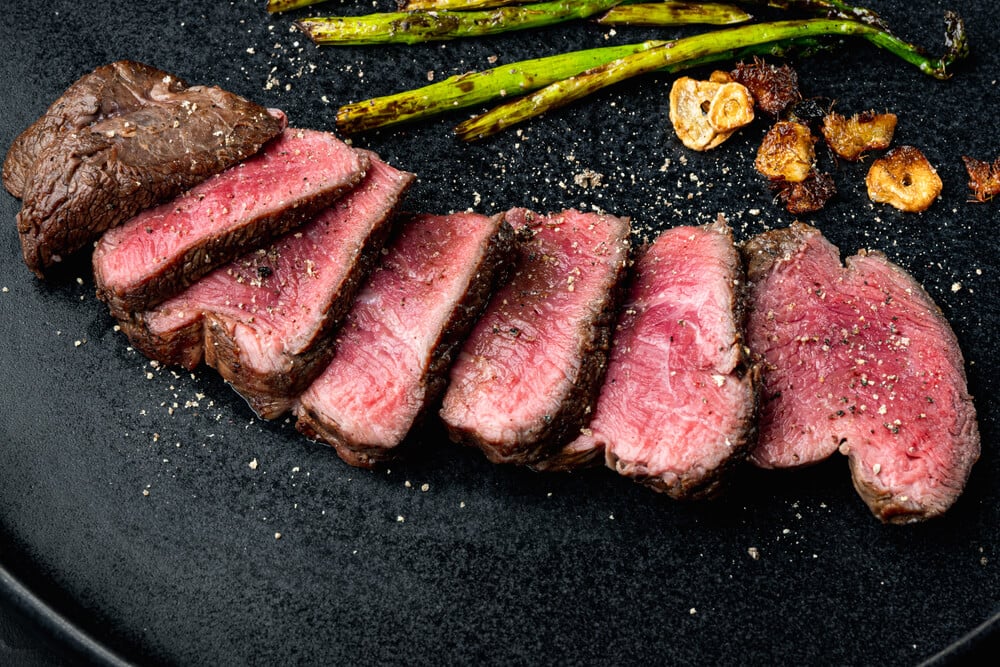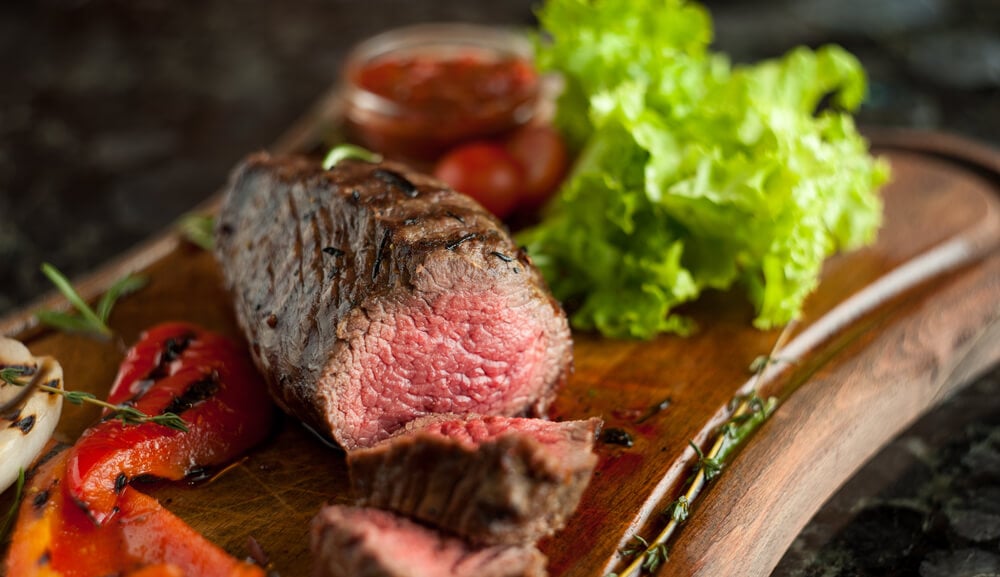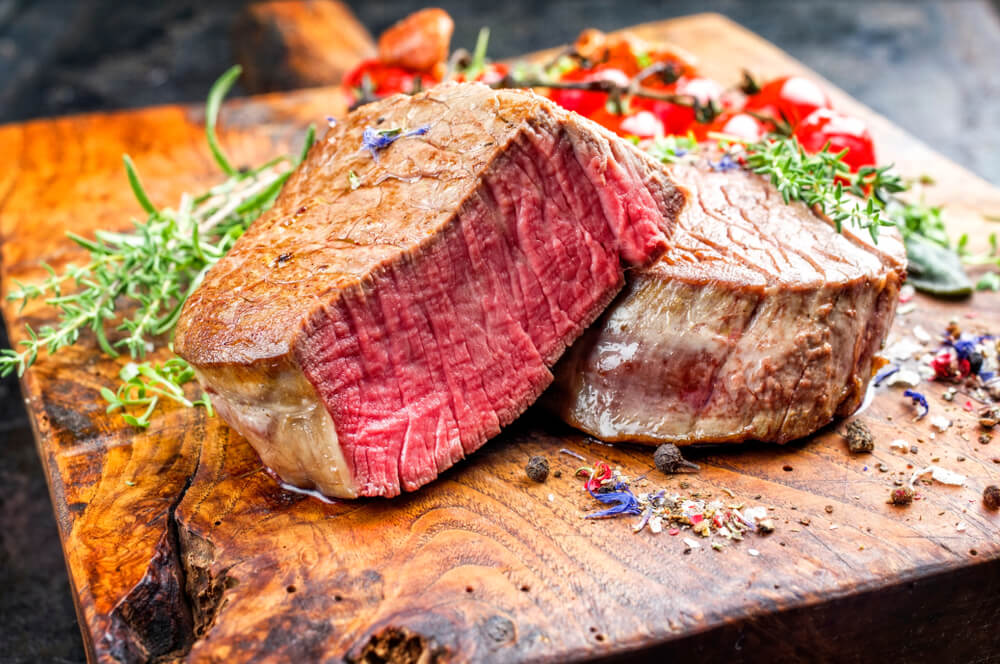
In one corner, a high-end steak with a fork-tender texture. In the other, a unique way of preparing a beef tenderloin roast that transforms it into a steak. Both are great for showing off your cooking skills and wowing your guests. But which is right for the next big occasion you have on your calendar? Make the right choice with this handy guide comparing the Chateaubriand vs Filet Mignon.
What is Chateaubriand?

The Chateaubriand is one of the more unique cuts of beef that has its own historical preparation method. This French name is applied to the center section of a beef tenderloin when it is cut into thirds. You may also find it labeled as a center-cut tenderloin roast. This cut is enough to serve two people at least and usually isn’t sliced into medallions until it has been cooked.
History
A center cut of the tenderloin earned the specific name Chateaubriand thanks to the Vicomte François-René de Chateaubriand. As with the Earl of Sandwich, this dish was created by his personal chef. However, the term originally referred to cooking any tenderloin with two lesser cuts of meat pressed to either side to keep it moist. These other cuts were discarded before the meat was served, which is a process rarely used now when cooking Chateaubriand.
What is a Filet Mignon?

Also cut from the beef tenderloin, the Filet Mignon is a medallion steak cut from the narrow end of it instead. This results in extra tender meat, even when grilled or smoked. Many people enjoy it without even using a knife to cut it since it can be fork-tender. Due to its texture and flavor, it’s considered one of the top cuts of beef. But since it is a leaner cut of meat, it’s not uncommon to see it paired with a rich sauce or wrapped in bacon before cooking.
History
The name Filet Mignon is also French, and it means delicate or fine filet. It was a name originally applied to the medallions cut from any tenderloin, but now it’s applied almost exclusively to the narrow cut of the beef tenderloin. These steaks have been considered luxurious and commanded a high price tag for many decades.
How Do Chateaubriand and Filet Mignon Differ?
While both of these rich cuts of beef originate from a similar location on the cow, they do differ in important ways. Consider the following when choosing between Chateaubriand vs Filet Mignon.
Nutrition
First, compare the nutrition details for these two steaks. Filet Mignon has 185 calories per 3-ounce serving, while Chateaubriand provides only 135 calories in a similar serving size. Both are relatively lean, with Chateaubriand having 6 grams of total fat and Filet Mignon having 9 grams of total fat per serving.
Marbling
Both cuts are lean and neither is highly marbled. Still, the Filet Mignon tends to feature slightly more intramuscular fat than the Chateaubriand.
Size
The Chateaubriand is a larger cut of meat, sometimes pounded out to create a steak that can be over 12 ounces in weight. Some weigh multiple pounds and have five to six servings. In contrast, the Filet is a smaller and rounder cut since it comes from the narrow part of the tenderloin. It also tends to weigh far less, with an average weight of anywhere from 4 to 8 ounces.
Number of Portions
Filet Mignon is generally sized so that each steak is a moderate serving for a single person. The Chateaubriand is much larger and is generally intended to serve two or more people.
Texture
Both are velvety and extra tender when cooked with slow and low methods. Still, the Filet Mignon has a slight edge when it comes to tenderness.
Flavor
Yet when you compare the flavor, most people consider the Chateaubriand to have the edge. Thanks to a denser grain, it’s richly flavored for being part of the soft tenderloin.
Where On The Cow Can You Locate Chateaubriand Vs Filet Mignon?
The same part of the cow produces both the Filet Mignon and the Chateaubriand. The beef tenderloin is located deep in the middle of the animal’s body, where the rump and the end of the rib cage come together. The filets come from the narrow end of the tenderloin, giving it superior tenderness. The Chateaubriand is the center cut of the same muscle tissue, offering a little more flavor with nearly the same texture.
Which Cut is More Expensive?
It largely depends on the source of the meat, but Filet Mignon tends to command a slightly higher price than the roast cut. Chateaubriand can cost nearly as much per ounce and comes in a much larger cut, so it will cost more in total as well.
When Should You Use Chateaubriand and When Should You Use Filet Mignon?
If you’re planning a special meal for yourself and someone else, consider a Chateaubriand since it’s perfect for sharing. Filet Mignon is easily purchased and cooked in the right number for any crowd from one person to 100. Chateaubriand is best paired with at least an au jus sauce, so be prepared to whip with a finishing touch when you cook this cut of beef.
Which is Better for Grilling?
Thanks to the slightly higher fat content, Filet Mignon responds well to the high heat of the grill. It’s easily seared and won’t lose too much juiciness. The Chateaubriand also responds well to grilling, but it needs to stay a whole roast to remain juicy in the center.
Which is Better for Smoking?
As with grilling, the Filet Mignon has the upper edge with this cooking method. Since these individual steaks are smaller, they cook quickly in the smoker and don’t dry out much. If you want to put a Chateaubriand in the smoker, consider wrapping it with bacon first to infuse some extra fat into the meat.
Which is Better for Oven Cooking?
The Chateaubriand won’t dry out during the slow and cooler cooking offered by the oven. It’ll develop a beautiful crust, especially if you sear it in a pan before putting it in the oven. Filet Mignon can turn out just fine cooked this way as well, but you’ll need to watch it carefully to prevent drying and overcooking.
Which is Better for Pan Frying?
An entire Chateaubriand is a little large to fry in a pan, but it can be seared that way. If you pound it thinner like many steakhouses do, you’ll find it takes to pan frying quite well. The Filet Mignon is easily cooked in a cast iron pan from the start, especially with bacon wrapped on the sides.
Conclusion
Whether you select a hearty Chateaubriand or the ultra-tender Filet Mignon, you’re sure to enjoy your steaks from Chicago Steak Company. Try both of them at different times to determine which of these two closely related cuts you prefer.

